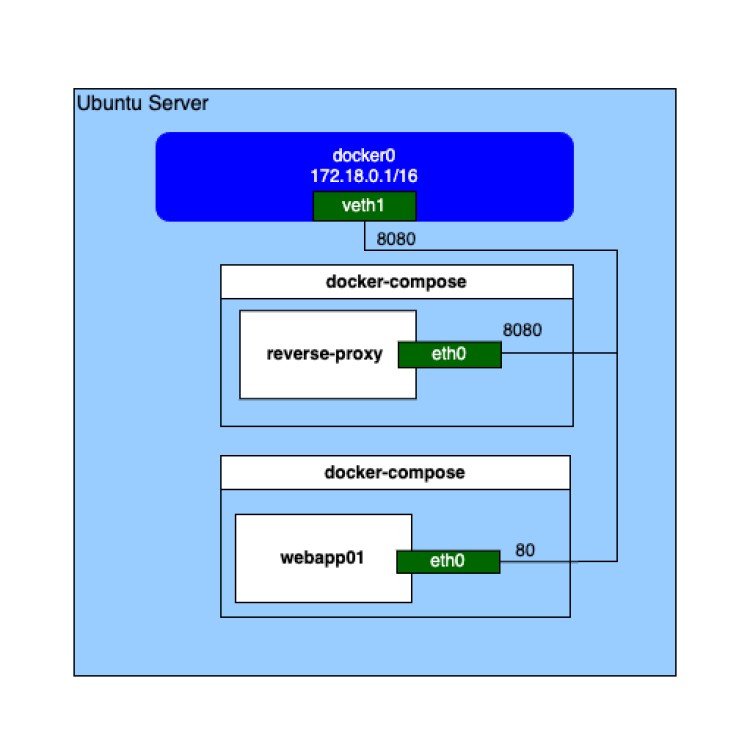Introduction
This is a tutorial for a configuration I plan to build later.
I'm a beginner with Docker and documenting this as part of my learning process, so the content may be incomplete.
Environment
- Host: Ubuntu 24.04
Architecture
We’ll create a reverse proxy and web container in the same network,
and configure it so that port 8080 forwards to port 80 of webapp01.

Directories
-
Create the root directory for the Docker project:
/home/docker/ -
Create directories for the reverse proxy and webapp01:
/home/docker/reverse-proxy
/home/docker/webapp01
Creating the Setup
Goal: Accessing localhost:8080 should display the web page from webapp01.
Create Docker Network
Use the command below to create a Docker network.
Normally, you’d specify subnet, gateway, etc., but we’ll omit those for this minimal example.
docker network create reverse-proxy-networkNginx Config for Reverse Proxy
Create the config file at:
/home/docker/reverse-proxy/conf.d/reverse-proxy.conf
Any .conf file in conf.d will be automatically loaded.
server {
listen 80;
server_name webapp01;
location / {
proxy_pass http://webapp01:80/;
}
}listen specifies the IP/port to receive requests (here: all IPv4 on port 80).
The location directive forwards requests — for now, it's minimal and does not include headers, timeouts, or SSL settings.
Reverse Proxy Service
Create a docker-compose file at:
/home/docker/reverse-proxy/docker-compose.yml
services:
reverse-proxy:
image: nginx:alpine
ports:
- "8080:80"
volumes:
- ./conf.d:/etc/nginx/conf.d
networks:
- reverse-proxy-network
networks:
reverse-proxy-network:
external: trueThis uses the lightweight nginx:alpine image.
Host port 8080 maps to container port 80.
The config directory is bind-mounted.
We specify an external network we created earlier.
Web Server Content
Create a sample HTML file:
/home/docker/webapp01/public/index.html
Write any content to confirm later via browser or curl.
Web Server Service
Create a docker-compose file at:
/home/docker/webapp01/docker-compose.yml
services:
webapp01:
image: nginx:alpine
volumes:
- ./public:/usr/share/nginx/html
networks:
- reverse-proxy-network
networks:
reverse-proxy-network:
external: trueMount the public folder to the default Nginx web root.
The same reverse-proxy-network is used.
Test the Setup
Start the Containers
Move into each project directory and run:
docker compose -p webapp01 up -d
docker compose -p reverse-proxy up -dCheck with curl
curl http://localhost:8080If successful, the contents of index.html should be returned.
You can also access via browser using the host's IP address.
Conclusion
We created a very minimal reverse proxy.
Since the config is small, everything built and ran smoothly.
Currently, we’re just forwarding ports.
Next steps include implementing port filtering and practical setups using iptables.